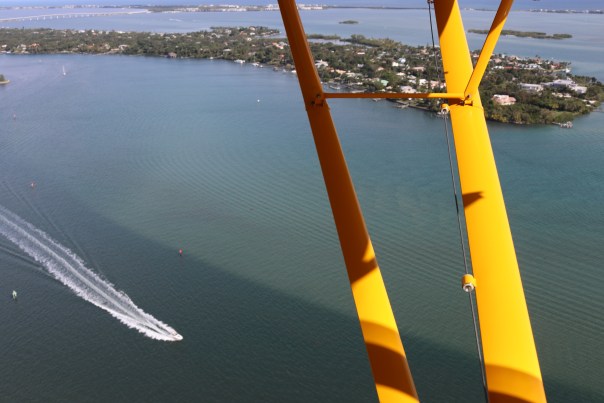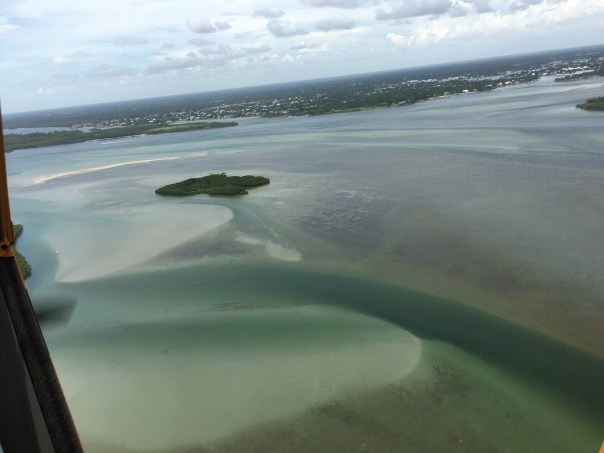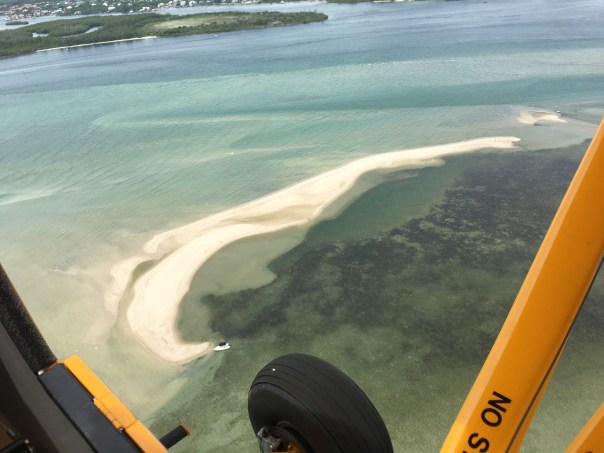-Captain Chris Wittman & Captain Daniel Andrews of Captains for Clean Water w/JTL & Ed. Shark River to Shark River Slough transition zone adventure, 3-24-21. Photo Noah Miller. I have had this fascination with finding the Shark River. Maybe it’s the visual; maybe it’s the promise of more water flowing south; maybe it’s because I keep having a hard time finding it…
I have had this fascination with finding the Shark River. Maybe it’s the visual; maybe it’s the promise of more water flowing south; maybe it’s because I keep having a hard time finding it…
Twice I had tried. Once, on a boat trip from Flamingo and another flying over with my husband. In both cases, really, the river eluded me. “How can something so big, be so hard to find?” I thought to myself. Well, some of that may be related to the complex changes humankind has made to the Everglades system. It took a day led by Chris Whitman and Daniel Andrews of Captains for Clean Water to meet this elusive river “face to face,” and even begin to understand it.
Before I share the story, I am taking my favorite book off the shelf: Landscapes and Hydrology of the Predrainage Everglades. These images, on pages 46 and 47, compare the hydrology of the Everglades south of Lake Okeechobee from 1850 to today. Even without clicking to study the image, one can see the changes. The Shark River, near the bottom of the system, receives considerably less water today than in its past. The River of Grass south of Lake Okeechobee, which includes Shark River Slough, has been blocked by roads, cut by canals, amputated in the north by the Everglades Agricultural Area, and pushed west from encroaching eastern development.  –A modern picture from the National Park System reveals what remains today inside of Everglades National Park and shows the connection of the Shark River to Shark River Slough. My goal was to meet this river and to do so my husband, Ed, and I met the Captains in Flamingo at Flamingo Marina. We were to cross through Whitewater Bay, then enter the “Little Shark River” and next, come face to face with the Shark River itself!
–A modern picture from the National Park System reveals what remains today inside of Everglades National Park and shows the connection of the Shark River to Shark River Slough. My goal was to meet this river and to do so my husband, Ed, and I met the Captains in Flamingo at Flamingo Marina. We were to cross through Whitewater Bay, then enter the “Little Shark River” and next, come face to face with the Shark River itself!
 Ed and my morning began at 3:00am. I don’t believe I have ever gotten up this early. The alarm rang and Ed excitedly said: “Time to get up! ”
Ed and my morning began at 3:00am. I don’t believe I have ever gotten up this early. The alarm rang and Ed excitedly said: “Time to get up! ”
“Already?” I replied, stuffing my head under the pillow.
After getting ready, we jumped in the car driving south from Stuart in total darkness to Homestead and entered Everglades National Park. We were to meet the Captains at 8:00am. We were on time, but Ed likes being early.
“Slow down Ed! You might hit a panther! I exclaimed.
“I’m following the speed limit Jacqui.” Ed replied. “Go back to sleep.”
The sun was coming up and a menagerie of wading birds gracefully glided overhead. The sun shone through their feathers in hues of oranges and pinks. “This is beautiful.” I said, starting to wake up.
“You should try getting up early more often-we could go fishing together.” Ed joked.
I rolled my eyes, “I would only get up this early to meet the Shark River, not to catch fishes!” We laughed.
We saw the sign for Flamingo. We had arrived.
The Captains were waiting; boat already in the water. After quick “hellos,” we waved goodbye to a sleeping crocodile and headed up the Buttonwood Canal to Whitewater Bay. It was so exciting! Finally, I thought, I will indeed meet the Shark River!
It was chilly but no wind. The water was like glass. There was no one else.
-Captain Daniel Andrews and Noah Miller in the Buttonwood Canal leading into Coot Bay. -JTL and Captain Chris Wittman.
-JTL and Captain Chris Wittman. -What a cool decking! “Send the water south!”
-What a cool decking! “Send the water south!” -Ed smiles for the camera.
-Ed smiles for the camera. Suddenly we stopped.
Suddenly we stopped.
“Is this Whitewater Bay?” I asked.
Chris nodded his head up and down and climbed above the engine. I noticed he was wearing no shoes, just socks.
“What’s he doing?” I whispered to Ed.
“He’s sighting tarpon. Shhh.” Suddenly I saw a tremendous splash in the distance! A rolling silver monster of a fish. It was spectacular! Never in my lifetime had I seen a jumping “silver king.”
Suddenly I saw a tremendous splash in the distance! A rolling silver monster of a fish. It was spectacular! Never in my lifetime had I seen a jumping “silver king.”
I watched. I listened. It was magical. And like the Shark River, the tarpon stayed just out of reach, remaining a mystery….
We continued on..
We traveled quite a long way, many miles, first hitting the Little Shark River and then the Shark River itself. Some maps like the one below show it all as the Shark River.
“Chris looked at me through reflective glasses. He smiled. “Here you go Jacqui, this is it. The Shark River.”
“Oh my Gosh finally! I exclaimed standing up.“Hello Shark River! I dragged my fingers in the clear, brownish water smiling from ear to ear.
It felt like we were in Africa or some far away land. The Captains were taking us deep into the northern reaches of Otter Creek and Rookery Branch as displayed on page 109 of The Everglades Handbook, another excellent publication. Chris said, “Not only are you going to meet the Shark River, we are going to take you to were its connection meets Shark River Slough.”  When we arrived at the end of the branch, the waterway got thinner and thinner, the plants began to change. We stopped when we could go no further. Captain Daniel explained that we were in the “transition zone.” Shark River Slough was just north of us, on the other side, where the vegetation would become more marshy. Fresh water flowed through here. I could see coco-plum, like in my yard, growing right next to mangroves. The vegetation was mixed and different. Daniel discussed the history and how the mangroves have grown much further north since around 1920 because of the lack of fresh water. I looked down. It was very shallow. I could see limestone, marl or some type of rock. What looked like peat and leaves lie on top. The water was clear. Fishes were darting about. I could see the water slowly flowing…
When we arrived at the end of the branch, the waterway got thinner and thinner, the plants began to change. We stopped when we could go no further. Captain Daniel explained that we were in the “transition zone.” Shark River Slough was just north of us, on the other side, where the vegetation would become more marshy. Fresh water flowed through here. I could see coco-plum, like in my yard, growing right next to mangroves. The vegetation was mixed and different. Daniel discussed the history and how the mangroves have grown much further north since around 1920 because of the lack of fresh water. I looked down. It was very shallow. I could see limestone, marl or some type of rock. What looked like peat and leaves lie on top. The water was clear. Fishes were darting about. I could see the water slowly flowing…
We were at the interface, the meeting place of river and slough. We talked about Everglades restoration for a long time noting that the water now wasted to tide and destroying the Northern Estuaries from Lake Okeechobee once flowed massively south through this area into Florida Bay. We talked about the hyper-salinity and seagrass die-offs in Florida Bay due to the lack of fresh water. Yes, recently, and in 2015, starting in the 1980s. What a conundrum. We must continue to work to send more water south!
-Captain Chris teaches us about the transition zone. -Transition zone between river forks and Shark River Slough. Blue dot is location of the boat. Line above is Tamiami Trail east of Miami.
-Transition zone between river forks and Shark River Slough. Blue dot is location of the boat. Line above is Tamiami Trail east of Miami.  Before heading home, the Captains took us in the opposite direction to see Ponce de Leon Bay, where the Shark River and other rivers carry the water of Shark River Slough into Florida Bay and the Gulf of Mexico.
Before heading home, the Captains took us in the opposite direction to see Ponce de Leon Bay, where the Shark River and other rivers carry the water of Shark River Slough into Florida Bay and the Gulf of Mexico.
Along the way, we passed a mangrove forest that contained giant remnant black mangroves the size of oak trees! I even saw a tree snail. I had never seen such a big tree snail either!
All the way home, I felt renewed.
I will never forget this special day. The day Ed and I had a Captains’ introduction to the Shark River -and so much more! Ed and I are forever grateful.
With every experience like this I can see, really see, what needs to be done to send more water south, to save the estuaries, and to replenish Florida Bay. Having met the Shark River, may just have been the ultimate inspiration.
 -Ponce de Leon Bay mangrove forest.
-Ponce de Leon Bay mangrove forest.  -Hugging an enormous ancient black mangrove.
-Hugging an enormous ancient black mangrove. -An Everglades tree snail!
-An Everglades tree snail!
 -Captain Chris overlooks Ponce de Leon Bay.
-Captain Chris overlooks Ponce de Leon Bay. -Heading home!
-Heading home!  -Back on land at Flamingo Marina. A final farewell selfie.
-Back on land at Flamingo Marina. A final farewell selfie.  -Crocodile loves the comfy boat ramp.
-Crocodile loves the comfy boat ramp. -Ospreys feed their rapidly growing young. All animals of the Everglades need flowing fresh water from Lake Okeechobee to Florida Bay. We must continue to send more water south!
-Ospreys feed their rapidly growing young. All animals of the Everglades need flowing fresh water from Lake Okeechobee to Florida Bay. We must continue to send more water south! 
Videos: 1 & 2 on the way to the transition zone of the upper forks towards Shark River Slough.
1.
2.
3. Approaching Ponce de Leon Bay that opens into Florida Bay and Gulf of Mexico.































































































































































 For years, I have had a reoccurring dream.
For years, I have had a reoccurring dream.























































































































































































































































